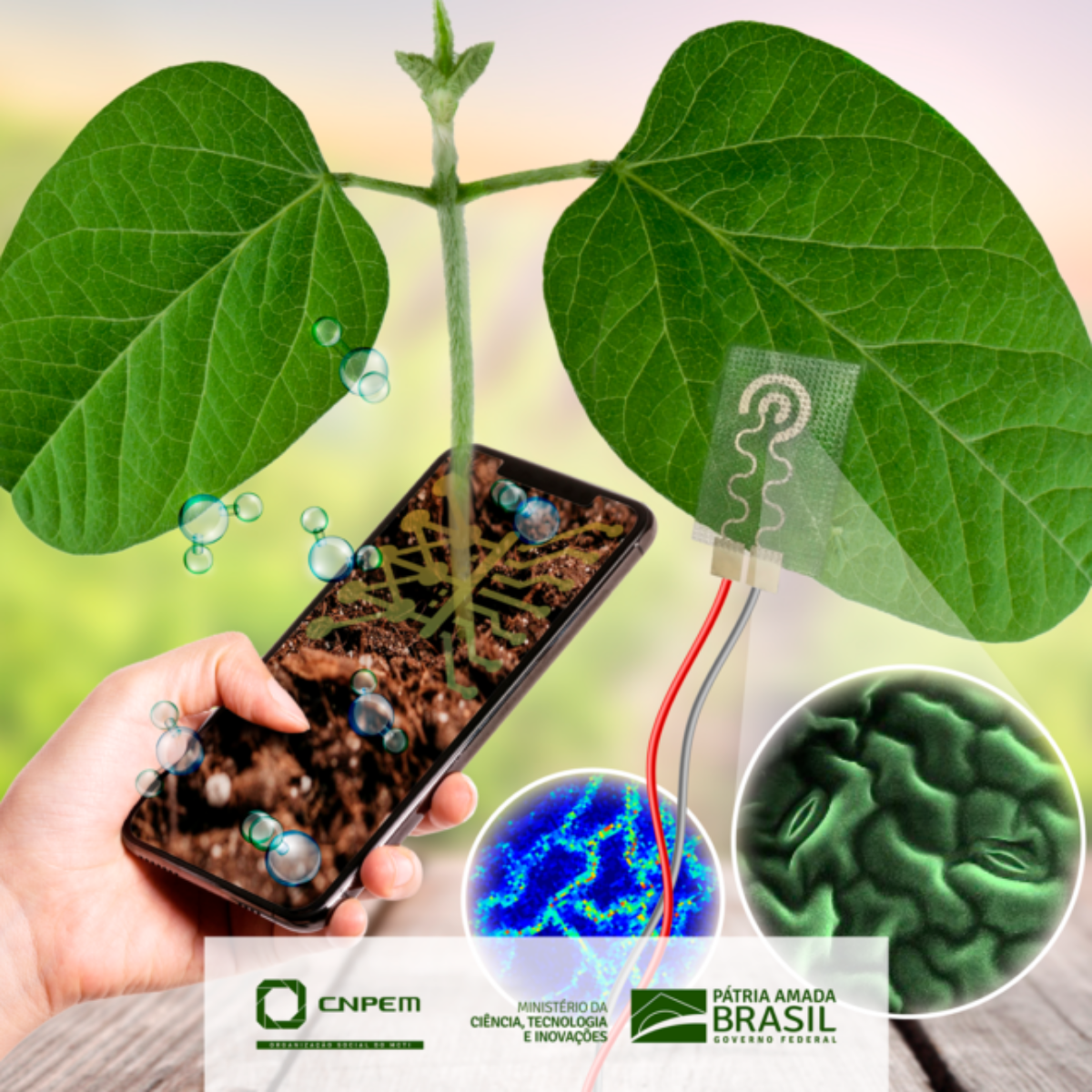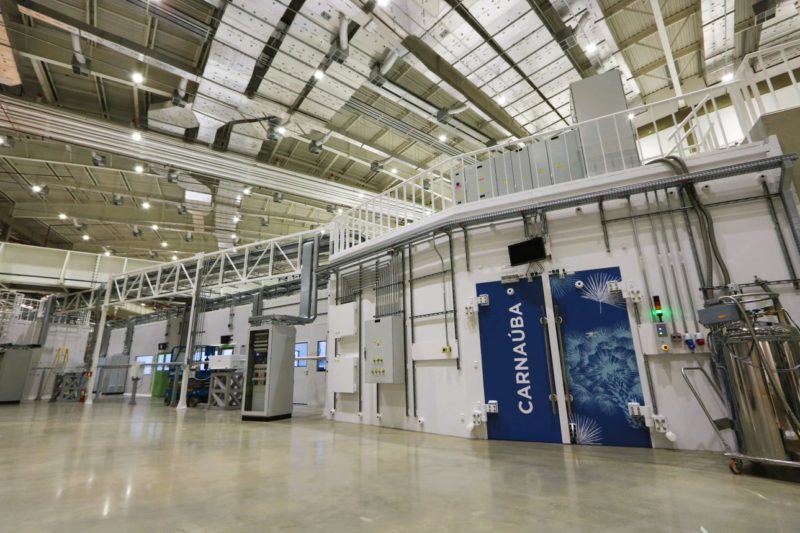
A prototype developed at CNPEM used sophisticated resources to assess device efficiency
Wearable sensors (wearables) are increasingly present in the lives of people who use electronic devices to monitor heart rate during physical activities, sleep quality, among many other sensitive standards for human health. Similar devices are being designed to use knowledge and technology to further monitor plant health in search of useful applications for precision agriculture.
Wearable sensors are a promising strategy to determine the loss of water content (LWC) from leaves, as they can provide on-site and non-destructive quantification of the water present inside them from a single measurement. As water content is an important marker of leaf health, real-time monitoring can provide valuable information to guide management in precision agriculture, as well as for toxicity studies and the development of new agricultural inputs.
“Conventional systems have limitations because they are based on imaging systems, satellites and drones. They need the plant attacked by disease to show phenotypic signs or visual clues to generate alerts in monitoring. In crops such as soybeans, for example, the colour change may only occur later, signalling an irreversible stage of diseases such as Asian rust”, explains researcher Renato Sousa Lima.
Despite technological advances in this area, the manufacture of suitable electrodes for plant monitoring poses challenges. The materials need to be light, flexible and able to adhere to the surface of the leaves, covered with trichomes, which protect them from insects and contribute to reducing water loss. In addition, they need to be biocompatible, that is, they cannot harm the biological processes of plant development. Overcoming all these challenges from one device as described in the article Biocompatible Wearable Electrodes on Leaf Toward On-Site Monitoring of the Water Loss from Plants recently published in the journal ACS Applied Materials & Interfaces and was selected to be part of a special issue of the journal dedicated to young researchers around the world (Special Issue: Early Career Forum).
The study, which used soybean and sugarcane plants as samples, is the result of a research project by the Brazilian Center for Research in Energy and Materials (CNPEM), an organization supervised by the Brazilian Ministry of Science, Technology and Innovation (MCTI), which mobilized a multidisciplinary team that includes researchers from Unicamp and Harvard, experts and resources from the Brazilian Nanotechnology National Laboratory (LNNano), the Brazilian Biorenewables National Laboratory (LNBR) and the Carnaúba do Sirius research station, under the responsibility of the Brazilian Synchrotron Light Laboratory (LNLS). In addition to the MCTI, FAPESP and CNPq funded the research.
The device developed at CNPEM uses an electrode obtained by lithography. A single piece covered by a thin nickel film fixed with the help of a micropore adhesive. An electric field generated by a capacitor is applied to this electrode. The polarization of nutrient ions present in the water very sensitively reveals minimal variations in impedance, or electrical resistance, which are related to the hydration levels of the plant.
“If you have more water, you have more ions, you load the system more, so the impedance decreases. If you have less water, fewer ions, you load the system less and the impedance increases”, exemplifies Lima.
Machine learning tools helped to select, within a wide spectrum of frequencies, the most suitable for monitoring references. It was also used to determine between temperatures of 30 and 20 °C the precise parameters for quantification of water loss in leaves under different microclimate conditions. The acquisition of data collected by the devices is done by Bluetooth, with the help of a smartphone, which allows automation of readings and remote monitoring, over the internet.
The main advantages of the device developed at CNPEM are portability, battery life (10 days), sensitivity, biocompatibility and security in data acquisition, which allow essential automation for remote monitoring. As there are no similar sensors on the market, the patent filing is already underway. The manufacturing methods of the device are well known and are already available even in small industries, which creates conditions for scalability of production and potential reduction of the final price if any company is interested in the technology and decides to transform it into a product.

Carnaúba beamline at Sirius – Photo: Publicity/CNPEM
The study used some of the most sophisticated features, such as techniques using synchrotron light, to in-depth assess the biocompatibility conditions of sensors on leaves. At the Carnaúba research station, at Sirius, a state-of-the-art electron accelerator, designed and operated by CNPEM professionals, spectrometry measurements attested to the non-interference of the device in the metabolism of soybean and sugarcane leaves. Conventional techniques would not allow measuring nutrient concentrations with the sensitivity and precision necessary to ensure biocompatibility. “In healthy leaves, zinc, manganese, calcium and iron ions, which are essential nutrients both for the structural part and for transport, obey a morphological structure, similar to that of capillaries, xylems and phloems. When the leaf is affected, the cells break down and there is no longer any pattern”, explains Lima.
At the current stage of development, the device proves to be quite efficient for use in controlled environments, but it is also very promising for monitoring in outdoor environments. Partnerships with the industry can bring different demands for improvement.
“The device demonstrated high sensitivity for evaluating the efficiency of the use of some management techniques or the impact of the use of inputs, as well as for potentially monitoring the conditions of production of the crops. We believe that with small adaptations it could also contribute as an additional resource in monitoring the toxicological conditions in the field”, evaluates researcher Julia Adorno Barbosa.
Research paves the way for the development of biological fungicides as an alternative to pesticides used to combat "pineapple sett rot disease", one of the most frequent pests in sugarcane fields
Superconductivity has the potential to revolutionize engineering and technology in lossless power transmission, more efficient electric motors, and other applications. These investigations have recently gained a new ally: Sirius.